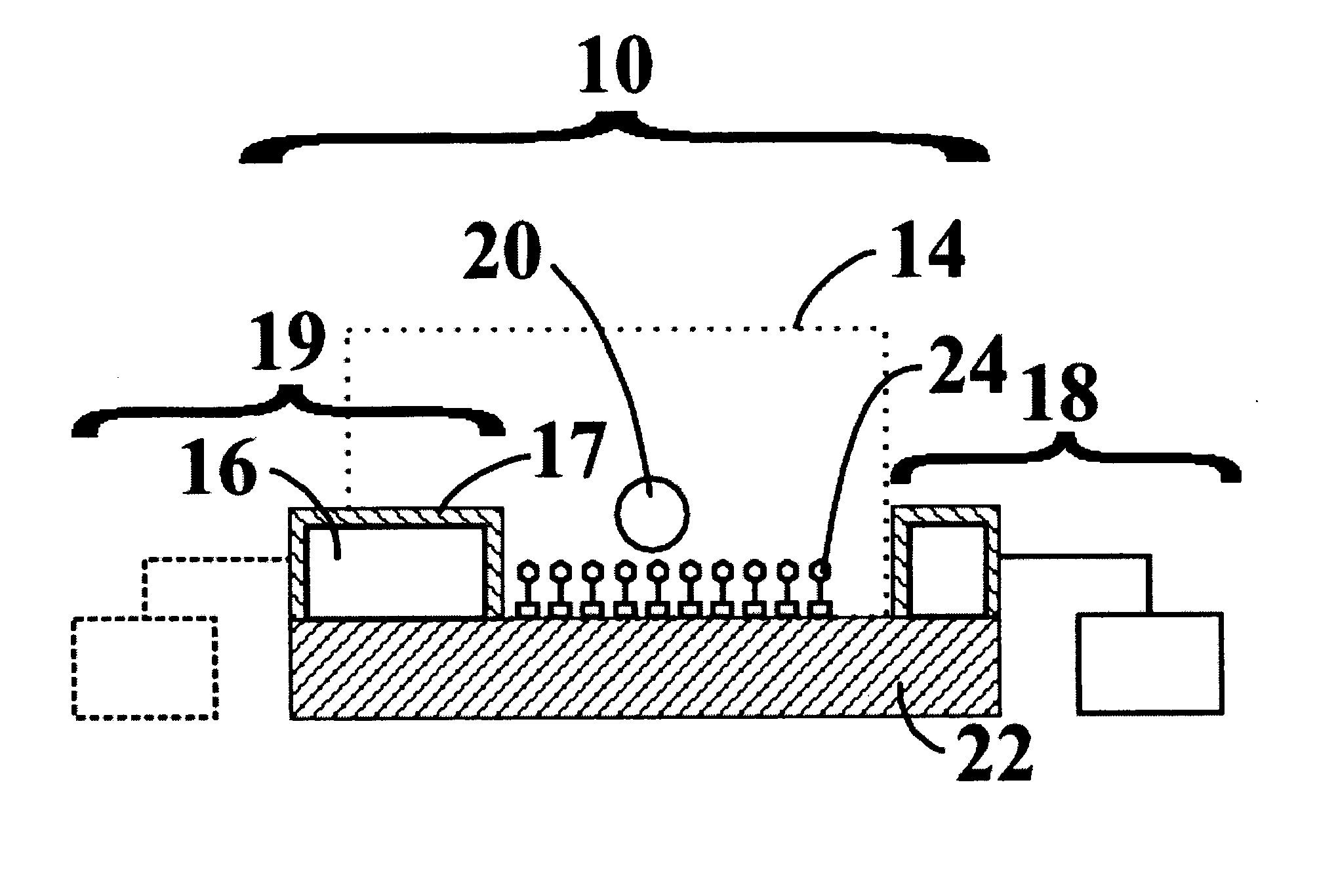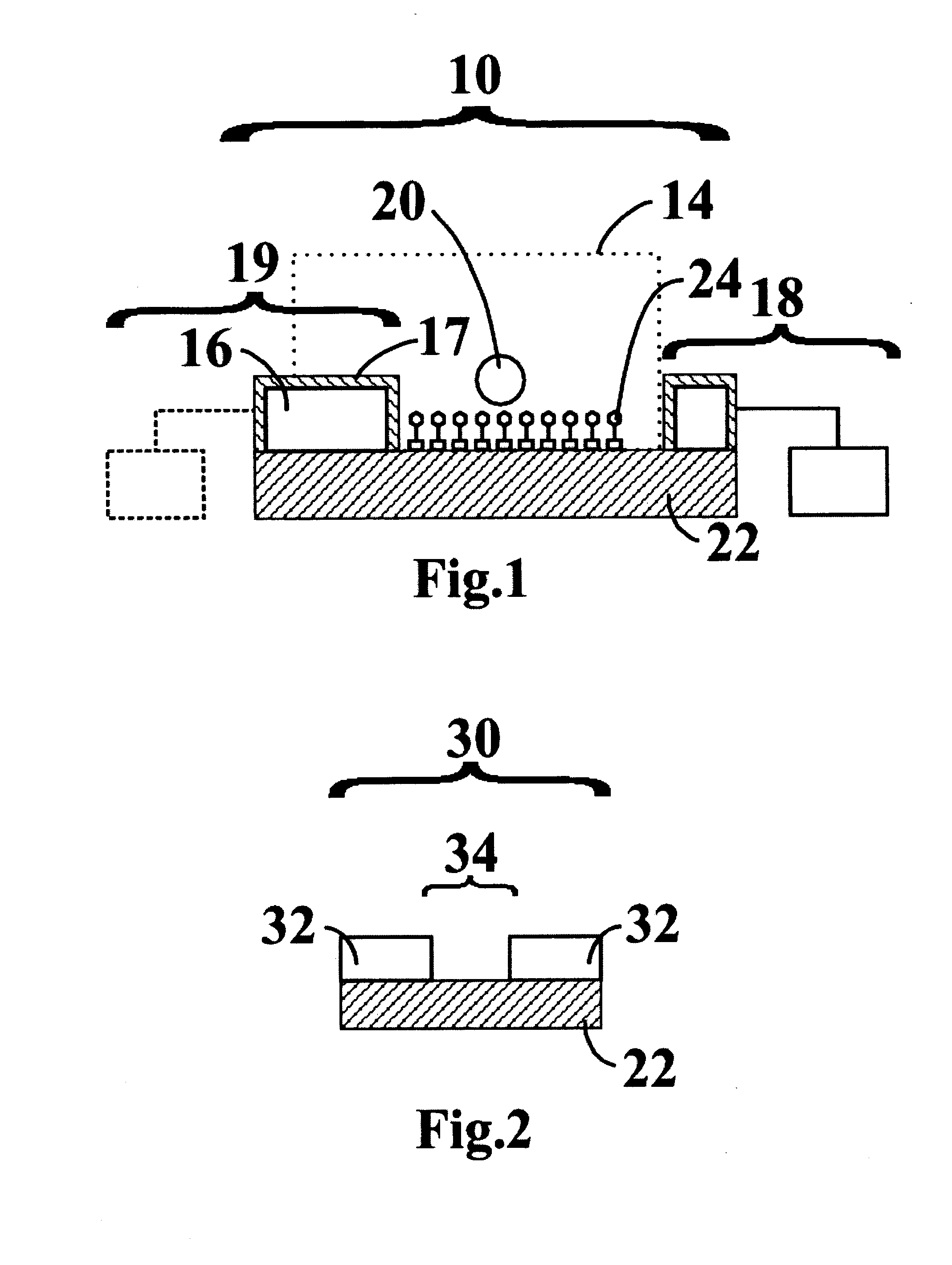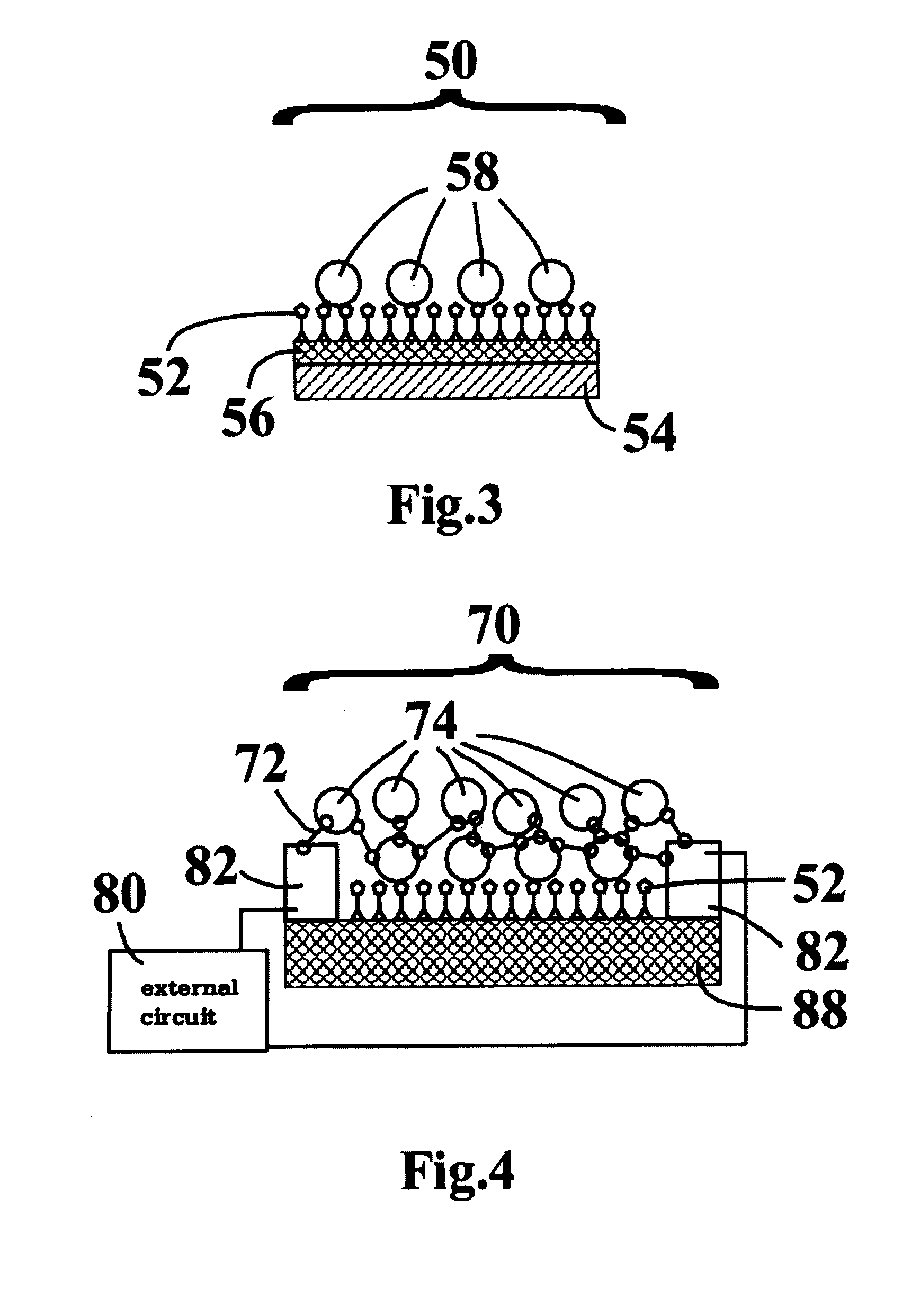[0023]In order to increase changes in VG induced by changes in ε, in turn induced by a target
analyte of interest, it is desirable to maximize the fraction of volume occupied by the target analyte of interest in the region sensed by the
electric field. This can be accomplished by
engineering electric fields as disclosed above and further by incorporating into the region sensed by the
electric field,
atomic species, functional groups, molecules, and more generally chemical and / or biological discrimination elements that interact with target analytes of interest. For example, if the region sensed by the
electric field is at or near a surface and the target analyte of interest is a strand of
DNA, then functionalizing the surface with a complementary strand of
DNA can generate higher concentrations of the strand of
DNA near the surface than in solution. Many interactions can be exploited in such a fashion to increase concentrations of target analytes of interest and will be apparent to those skilled in the arts. The interactions include electromagnetic and / or
quantum interactions such as those that give rise to
antigen-
antibody paring, DNA hybridization, and interactions between other
biological species, various chemical phenomena such as bonding,
solubility, and the like. Such interactions generate various degrees of chemical and / or biological discrimination and will be apparent to those skilled in the arts. Such increases of concentrations have an advantageous feature of overcoming a problem that arises generally for devices and methods that rely on measurements of bulk properties such as
conductivity and bulk dielectric constant. As
solvent composition changes during
gradient elution, there arises a large change in bulk properties, making detection of small changes generated by target analytes of interest difficult. Increasing the
volume fraction of target analytes of interest in the region sensed by the electric field has advantageous effects of reducing the
volume fraction of the solvents and mitigating the detrimental influence of changing
solvent composition.
[0024]If media in which target analytes of interest are dissolved are non insulating, the media will have finite conductance and therefore resistance. Hence they generate dissipation in the
capacitance, a real component in the measured
voltage, a complex component in ε and a complex component in the measured
voltage that involves both resistance and
capacitance. As resistance decreases, current increases, leading to saturation of
electronics especially if RG is increased to detect small changes in ε. Determination of capacitative impedance, and therefore, small changes in ε become difficult. To address this problem, it is desirable to develop methods and devices employing an insulating region that impedes external current flow so as to permit detection of even small changes in ε.
[0025]A simple-to-use, inexpensive,
label-free, portable, quantitative, robust, sensitive, structurally and chemically stable and generally applicable invention for detecting, distinguishing, and characterizing target analytes of interest and other species is, therefore, highly desirable. In particular, it would be highly desirable to have an invention that is based on a property universally possessed by all target analytes of interest (for example, ε) and that is insensitive to changes other than those induced by target analytes of interest. Such an invention would have many other applications, besides monitoring separation of mixtures. These applications include, but are not restricted to, monitoring interactions between surfaces functionalized with chemical and / or biological discrimination elements (such as unfunctionalized molecules, mono-functionalized molecules, bi-functionalized molecules, poly-functionalized molecules, oligomers, polymers, catalysts, cells,
bacteria, viruses, enzymes, proteins, heptans, saccharides, lipids, glycogens,
enzyme inhibitors,
enzyme substrates, neurotransmitters, hormones, antigens, antibodies, DNA, and / or
RNA), and pharmaceutical, biological and / or medically related compounds (such as drugs, DNA,
RNA, proteins, antigens, antibodies, heptans, saccharides, lipids, glycogens,
enzyme inhibitors, enzyme substrates, neurotransmitters, hormones, viruses,
bacteria, cells, etc.) The invention can also be used for
quality control tests in which results obtained using a
control system are compared with those obtained using a test
system. Such tests would be useful to monitor whether a chemical has become contaminated for instance. The invention can further be used in tests for monitoring water. Other uses for such an invention will be apparent to those skilled in the arts.SUMMARY OF THE INVENTION
[0026]It is a primary object of the present invention to provide a dielectric sensing device and method. In one embodiment of the invention, the device includes at least two electrodes integrated on a monolithic architecture to ensure rigidity and
mechanical stability. A time-dependent voltage is applied to at least one of the electrodes and a current induced by the time-dependent voltage is measured. The current may be amplified by electronic circuits and its magnitude and phase relative to those of the voltage can be measured. Such measurements provide information about the capacitance of the electrodes. The electrodes are fabricated such that their sizes and / or separations are, for example, similar to size scales of target analytes of interest so as to improve
signal-to-
noise ratio in capacitance measurements. For example, electrodes with sizes and / or separations that are on a nanometer scale may be used when detecting target analytes of interest that are nanometers in size. If nanometer-sized target analytes of interest form larger structures such as multilayers or other aggregates, then electrodes with sizes and / or separations that are correspondingly larger in size are preferred. When a target analyte of interest approaches said electrodes, capacitance measured at the electrodes may change due to a change in effective dielectric constant sensed by the electrodes. To facilitate sufficient amplification of capacitative current and, therefore, to facilitate detection of small changes in effective dielectric constant, it is advantageous to increase the resistive component of conductance. Accordingly, the invention advantageously employs a sufficiently insulating region that impedes external current flow to and / or from said electrodes.
[0027]Chemical and / or biological discrimination elements can be employed to improve detection of target analytes of interest. When a target analyte of interest approaches said electrodes and interacts with the chemical and / or biological discrimination elements for a period of time, a change in effective dielectric constant sensed by the electrodes occurs. Qualities of the change, such as its magnitude, duration, robustness, specificity, selectivity, sensitivity, etc., can be enhanced through interactions between the chemical and / or biological discrimination element and target analytes of interest. As examples, interactions between nonpolar target analytes of interest are favoured when nonpolar chemical and / or biological discrimination elements are used; interactions between polar target analytes of interest are favoured when polar chemical and / or biological discrimination elements are used; interactions between
antigen target analytes of interest are favoured when conjugate
antibody chemical and / or biological discrimination elements are used; etc.
[0028]The chemical and / or biological discrimination element may be, for example, bound to the rigid architecture between electrodes, to one
electrode or to a plurality of electrodes. Furthermore, in this embodiment of the invention, use of
electronic circuit methods for capacitance measurements affords several advantageous features, including
miniaturization, integration, portability, high signal-to-
noise ratio, high sensitivity, ease of availability of components, an existence of a wide selection of components,
modularity and low fabrication cost.
 Login to View More
Login to View More 


